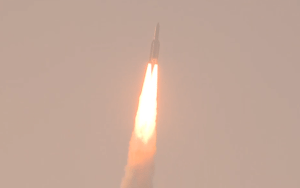Latest News
[Via Satellite 10-01-2015] European launch provider Arianespace has orbited two telecommunications satellites for customers in Latin America and Australia. The Flight VA226 Ariane 5 mission carried NBN Co’s first satellite, Sky Muster, and Empresa Argentina de Soluciones Satelitales Sociedad Anonima’s (ARSAT) second satellite, ARSAT 2. Flight VA226 is Arianespace’s ninth mission of 2015. The company is aiming for a new record of 12 launches in a year with the Ariane launcher family. Both customers of yesterday’s Ariane 5 launch are guiding their spacecraft to their final orbits, and preparing them for services in their respective markets.
NBN Co
Set up in 2009 by the Commonwealth of Australia, NBN Co is tasked with meeting the country’s policy initiative to provide broadband connectivity to all premises across the continent. By 2020, NBN Co aims to connect 8 million homes and businesses across the country. The government-owned organization is deploying multiple telecommunications technologies to reach this goal, including a pair of Ka-band satellites. The recently launched Sky Muster is an all Ka-band High Throughput Satellite (HTS) with multiple spot beams designed to reach Australia’s widely distributed population. Built by SSL, the satellite has deployed its solar arrays, and is expected to enter service in the first half of 2016.
The second of NBN Co’s satellites, also from SSL, is scheduled to launch in the second half of 2016 with Arianespace. ViaSat built 10 ground stations to support the satellite system, each of which has two 13.5-meter satellite dishes.
NBN Co has supplied broadband to 48,000 locations through its Interim Satellite Services (ISS) and the NBN Satellite Support Scheme (NSS). Thaicom’s IP Star satellite enabled the NSS service, which was specialized for Australians outside the reach of commercial broadband. With its new satellites and supporting ground system, NBN Co plans to offer broadband connectivity to more than 200,000 remote homes and businesses. The commonwealth company plans to offer speed options for Internet Service Providers of 12Mbps downlink and 1Mbps uplink, or 25Mbps downlink with a 5Mbps uplink.
Sky Muster is the 100th satellite from SSL. Bailey Brooks, a six-year-old student from the School of the Air, got the opportunity to name the spacecraft after wining a nationwide NBN drawing competition that invited children to illustrate how the satellite network would help make Australia a better country. The name references how the satellite will “round up” and help connect Australians together.
NBN Co signed additional broadband infrastructure contracts ahead of the launch with several companies for Fiber to the Node (FTTN), Fiber to the Building (FTTB) and Fiber to the Premises (FTTP) rollout across the country. The company also recently launched FTTN, starting at Belmont, NSW, with the goal of getting 500,000 premises ready for service by mid-2016 and 3.7 million by mid-2018. NBN Co anticipates more than 1.6 million homes and businesses will be connected via FTTN by mid-2018. Trials have demonstrated wholesale download speeds of 100 Mbps and upload speeds of 40 Mbps.
ARSAT
The second in a trio of satellites from Argentine technology company INVAP, ARSAT 2 carries Ku- and C-band payloads for Direct-to-Home (DTH) television, VSAT Internet access, data transmission, and IP telephony. The satellite’s coverage reaches South America, North America up to the Canadian tundra, and down to the Antarctic Peninsula. The satellite builds on ARSAT’s desire to meet Argentina’s domestic telecommunications demand and compete on the international market. The company’s Benavidez Earth Station will send directions to maneuver the satellite into Geostationary Earth Orbit (GEO).
Established in 2006, ARSAT is a government company owned 98 percent by Argentina’s Ministry of Planning, Public Investment and Services, with the remaining 2 percent belonging to the Ministry of Economy and Public Finance. The company’s first satellite, ARSAT 1, launched in October 2014 as the secondary payload in an Ariane 5 launch with Intelsat 30. Located at 71.8 degrees west, ARSAT 1 provides telecommunications services to Argentina, Chile, Uruguay and Paraguay. Thales Alenia Space and Airbus Defence and Space supplied equipment to INVAP for ARSAT 1.
ARSAT and INVAP, along with other partners, have now turned their attention to ARSAT 3, a 3,000 kg satellite that will round out the initial constellation. Hours before the launch of ARSAT 2, the operator signed an agreement with Arianespace for the launch of ARSAT 3 aboard an Ariane 5 in 2019. The company also signed launch agreements with Arianespace for two more missions. The contract provides launch slots for two geostationary satellites planned for the 2020 to 2023 timeframe.
Get the latest Via Satellite news!
Subscribe Now